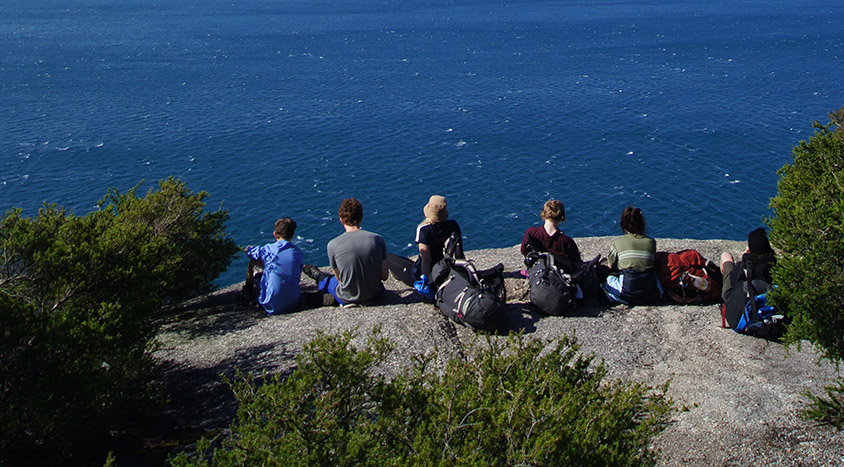Lying in my tent at the Stockyard Flat campground, I listened to the rain pour down and worried whether the students had set their tents up properly. The lightning turned night into day and the resulting thunder made the ground tremble.
Mother Nature was bearing down on Wilsons Promontory National Park and we hadn’t even taken our first steps. But I shouldn’t have been surprised. It’s a place with some of the most fickle weather I have ever experienced. As a friend of mine always jokes: “The Prom makes its own weather systems.”
As Victoria’s oldest national park The Prom holds significant history to both indigenous Australians and European settlers alike. Shellfish middens can be located throughout the park and whalebones can be found at some remote hiking campsites, dating back to a time when the area was used extensively as a whaling and sealing area. And these are just some of the reasons that schools and tourists come here in droves to camp at the Tidal River campgrounds or hike the many trails that exist within the park – all within reach of a couple hours’ drive from Melbourne.
Loading up a minibus with packs and students is not everyone’s idea of fun, especially having to make the long drive from central Victoria to the southern coast. It was a small class of varying abilities and experience; some excited, others taking a typically teenage attitude to the situation, using a series of grunts to communicate and curious as to why an outdoor education class would actually have to undertake a three day bushwalk.
Day 1
Most hiking groups walk the Telegraph Saddle, Little Waterloo Bay, Sealers Cove loop; a moderate 36-kilometre journey along a mixture of beaches, sand dunes, woodland and forest; camping at a choice of three different sites. The direction you choose matters little but on this occasion we began by heading down Telegraph Track towards Little Waterloo Bay.
On previous trips, I have begun the hike from Tidal River campground, walking the coastal route via Oberon Bay. This eliminates having to walk on a gravel road and enables you to take in the breathtaking, and often wild, views along the coast. High winds can make Oberon Bay itself more of a challenge as you negotiate a windswept, seaweed minefield before the track turns inland. Students in particular enjoy walking along the beach itself, keen to explore and determine the cause of death of the odd bird carcass or occasional seal. Although more scenic, logistics meant we weren’t to take this route on this particular occasion.
We’d made the decision to separate students from their mobile phones upon arrival so as to connect them more with their surroundings and each other. They were an eclectic group, so any interaction was a good thing. In return, the students thought that we were into cruel and unusual punishment for the act. What followed was an uneasy truce.
Teenagers have a funny way of approaching a walk like this. It is not so much their expressed shock that they may have to walk up a hill or walk through a creek, but instead revolves around the annoying use of the term ‘YOLO’ – you only live once – to dismiss anything. It gets used routinely in regards to every aspect of the hike.
“Do your waist strap up, please. It’s bad for your body otherwise.”
“Oh well. YOLO.”
“Would you rather be comfortable or in pain?”
“YOLO.”
“Bloody hell.”
“My back hurts…”
But once we were all underway, temporary grievances were soon forgotten.
The Prom’s plant life, in parts, is incredibly thick, providing fantastic protection from the wind, but exposed areas leave you at the mercy of the elements. It can also make spotting wildlife difficult. At one point, a massive, black feral cat emerged from the bushes on the side of the track, one hundred metres ahead. When I say ‘cat’ I actually mean ‘mountain lion’. It was huge, stopping to stare at us while I tried to get the attention of the group, most of whom were too busy concentrating on walking in a straight line with full backpacks to notice a cat the size of a small car, which quickly disappeared back into the bush.
Once turning off the gravel road at Telegraph Junction, the track becomes an actual walking trail; something the students were strangely relieved about. It seemed more like the bushwalk that they were promised. It undulated gently rather than containing any sharp climbs or descents. Australian grass trees littered the scenery as we meandered through both swampy and sandy landscapes littered with rocky outcrops. Only the last kilometre of the day contained a short climb, as we walked into Little Waterloo campsite.
There was already another school group in camp as well as some other hikers. This is a pitfall of school camp locations, they are extremely popular. Ordinarily this wouldn’t have been a concern, but due to the rain, half the sites were underwater, fit only for the vocal frogs and a resident, obese wallaby…
The story continues in Wild 159. Subscribe today to receive your copy.


